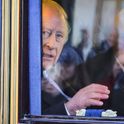The historian Ian Kershaw is the author of an acclaimed two-volume biography of Hitler. His latest book, “To Hell and Back: Europe 1914-1949”, is the first in a two-volume history of modern Europe (and is part of Penguin’s “History of Europe” series, edited by David Cannadine). This volume ends in 1949, just as the reconstruction of Europe after what Kershaw calls the continent’s “self-destruction” is beginning. Its successor will take him up to the present day.
I spoke to Kershaw in London in the autumn and began by asking him why he decided to end this part of the story in 1949, rather than the more obvious punctuation point of 1945, when hostilities formally ended.
IK: 1945 is the obvious place to stop. And I thought of stopping there. 1946-49 is a transitional era. In 1946, just after the war, Europe’s in terrible shape. It seems unthinkable that Europe would recover so rapidly from that catastrophe. I thought I would take the story on to see how the beginnings of a new era were possible. A German friend said to me: “Very nice, you’ve ended with the creation of two Germanys in 1949.”
JD: But presumably, in the first instance, that period was concerned more with reckoning than with reconstruction?
Yes, initially. The first phase was to do with the reckoning, and naturally enough, in all these [European] countries, the first stage after the liberation was, “Now we have to have a reckoning with the people who brought us to catastrophe.” That was done in different ways, as I try to outline [in the book]. But quite rapidly, as the Cold War begins to set in, they turn to questions of reconstruction.
You can see this also in foreign policy, with the emergence of Nato. In economic terms, [western European countries] are asking if it makes sense to keep Germany on its knees—you need Germany for economic recovery. So the whole thing turns quite swiftly. You move from a period of recrimination and reckoning to one of rebuilding.
You write that “denazification” was largely a failure. Why was that? And what were the consequences?
The answer to the first question is that the logistics were totally impossible. In [countries other than Germany] you were dealing with a tiny number of collaborators and you could sort them out relatively quickly. In Germany, where millions of people were involved in one way or another with the Nazis, how could you have gone about the same process? They [the Allies] couldn’t do it.
Whatever intentions they started out with, in a year or two it [was clear] that it was more important to get [Germany] stabilised in terms of building a bulwark against Soviet Communism. So the drive rapidly went out of the denazification process.
What were the consequences? Well, an obvious consequence—and the same was true in Austria—was that large numbers of people who’d been involved in pretty shady things got away with it. They were reintegrated into society or had their crimes hushed up. Stabilising democracy was seen as more important than rooting out the Nazis in their midst. So you had this period of self-imposed collective amnesia, because the future, it was thought, was more important than the past.
That unfinished business becomes particularly contentious in Germany in the mid-to-late Sixties doesn’t it? The student unrest in May ’68 in Germany was in part an attempt to begin an overdue reckoning with it.
It had started a bit before with the Eichmann trial [in Israel in 1961-62] and the Auschwitz trials [in Germany in 1963-65]. So people’s eyes had been opened. Then you had a new generation coming along and the ’68 student demonstrations when attention is turned towards Nazism in a way that it hadn’t been before.
[gallery ids="41372,41374,41375"]
Let’s go back to the beginning of the story you’re telling in this book. If one were trying to describe it in a slightly old-fashioned idiom, you might say that this is a book about the origins of the Second World War. Would it be at all accurate to describe it in that way?
I think that’d be a bit of a shortcut. It’s [about] why Europe plunged into a double catastrophe in the first half of the 20th century, and how it then started to emerge from that double catastrophe to bring about, unexpectedly and in a short space of time, the beginnings of decades of peace and prosperity.
In the introduction to this book you identify four interlocking factors which led to the “self-destruction of Europe”: ethno-nationalist conflict; territorial conflict, fomented, presumably, by the shortcomings of the Treaty of Versailles; class conflict stimulated by the Russian Revolution; and the crisis of capitalism. Which of those do you think contributed most to the outbreak of war in 1939, or do you think that, by themselves, they were necessary but not sufficient for the conflagration?
Each of them individually was a necessary component but insufficient on their own to cause the catastrophic destruction that ensued in the Second World War. Each of those factors was present in an extreme way in Germany [between the two World Wars], and bundled together they provide the explosion.
Does the traditional idea of a “German problem” or “German question” in Europe have any explanatory force here?
When you try to explain complex developments, some of these shortcut arguments are not wrong, they’re just insufficient. To say that something like the “German problem” is the reason we had two world wars really won’t do. But Germany is at the centre of events. And for that matter, even in the second half of the century, if you look at what happens after the war—the Cold War, the economic miracle, then the end of the Cold War—Germany is somehow central to everything that happens.
You have a chapter entitled “Hell on Earth” which deals with the war itself and the Holocaust. You say there that securing food for Germany’s population was the imperative that was driving its war aims. Timothy Snyder, in his recent book Black Earth, argued that one could also understand the Final Solution in terms of ecological panic. Would you go that far?
Economic arguments, including the quest for land and food, are obviously part of this onslaught on Eastern Europe. The Jews, though, were a small number, six million or so, out of the whole population of Eastern Europe. In 1941, the “general plan” for the east spoke about transplanting 30m people from that area over the next 25 years. That is more closely connected to the securing of land and wealth than the destruction of the Jews.
[Snyder’s] argument, therefore, is putting the cart before the horse. In Hitler’s own thinking, vicious, lethal and exterminatory anti-Semitism comes first. You find that in his speeches in the very early 1920s. The Lebensraum stuff comes in later on.
How does Hitler’s prosecution of the war dovetail with the Final Solution? You point out that the invasion of the Soviet Union in 1941 turns genocidal almost from the start.
At the beginning, from the very day they entered the Soviet Union, German security police were killing large number of Jews—mainly male Jews, initially. The next step came in late July and August [of 1941], when they then started [killing] women and children as well. That was a major step up only a few weeks after they’d begun Operation Barbarossa. It becomes wholesale extermination relatively quickly.
How does it dovetail [with the conventional war effort]? As the plans for [the invasion of] Russia were building up, the idea was then to send them to inhospitable parts of the Soviet Union. But once the war stalls, they can’t do that either, so [you ultimately] get the notion of death camps in Poland.
At the end of the introduction, you make the very important point that while the Second World War outdid the First in moral squalor and the sheer scale of the slaughter, it nevertheless paved the way for the extraordinary rebirth of western Europe, at least, after the War. So one of the things this book is trying to do is to work out how that was possible.
I started out with this complicated double question. First how was it possible to plunge into this level of catastrophe? Second, how and why did Europe begin on the route out of this? The second volume will take that on and will probably end on an equivocal note.
Ian Kershaw’s “To Hell and Back: Europe 1914-1949” is published by Allen Lane (£30)
I spoke to Kershaw in London in the autumn and began by asking him why he decided to end this part of the story in 1949, rather than the more obvious punctuation point of 1945, when hostilities formally ended.
IK: 1945 is the obvious place to stop. And I thought of stopping there. 1946-49 is a transitional era. In 1946, just after the war, Europe’s in terrible shape. It seems unthinkable that Europe would recover so rapidly from that catastrophe. I thought I would take the story on to see how the beginnings of a new era were possible. A German friend said to me: “Very nice, you’ve ended with the creation of two Germanys in 1949.”
JD: But presumably, in the first instance, that period was concerned more with reckoning than with reconstruction?
Yes, initially. The first phase was to do with the reckoning, and naturally enough, in all these [European] countries, the first stage after the liberation was, “Now we have to have a reckoning with the people who brought us to catastrophe.” That was done in different ways, as I try to outline [in the book]. But quite rapidly, as the Cold War begins to set in, they turn to questions of reconstruction.
You can see this also in foreign policy, with the emergence of Nato. In economic terms, [western European countries] are asking if it makes sense to keep Germany on its knees—you need Germany for economic recovery. So the whole thing turns quite swiftly. You move from a period of recrimination and reckoning to one of rebuilding.
You write that “denazification” was largely a failure. Why was that? And what were the consequences?
The answer to the first question is that the logistics were totally impossible. In [countries other than Germany] you were dealing with a tiny number of collaborators and you could sort them out relatively quickly. In Germany, where millions of people were involved in one way or another with the Nazis, how could you have gone about the same process? They [the Allies] couldn’t do it.
Whatever intentions they started out with, in a year or two it [was clear] that it was more important to get [Germany] stabilised in terms of building a bulwark against Soviet Communism. So the drive rapidly went out of the denazification process.
What were the consequences? Well, an obvious consequence—and the same was true in Austria—was that large numbers of people who’d been involved in pretty shady things got away with it. They were reintegrated into society or had their crimes hushed up. Stabilising democracy was seen as more important than rooting out the Nazis in their midst. So you had this period of self-imposed collective amnesia, because the future, it was thought, was more important than the past.
That unfinished business becomes particularly contentious in Germany in the mid-to-late Sixties doesn’t it? The student unrest in May ’68 in Germany was in part an attempt to begin an overdue reckoning with it.
It had started a bit before with the Eichmann trial [in Israel in 1961-62] and the Auschwitz trials [in Germany in 1963-65]. So people’s eyes had been opened. Then you had a new generation coming along and the ’68 student demonstrations when attention is turned towards Nazism in a way that it hadn’t been before.
[gallery ids="41372,41374,41375"]
Let’s go back to the beginning of the story you’re telling in this book. If one were trying to describe it in a slightly old-fashioned idiom, you might say that this is a book about the origins of the Second World War. Would it be at all accurate to describe it in that way?
I think that’d be a bit of a shortcut. It’s [about] why Europe plunged into a double catastrophe in the first half of the 20th century, and how it then started to emerge from that double catastrophe to bring about, unexpectedly and in a short space of time, the beginnings of decades of peace and prosperity.
In the introduction to this book you identify four interlocking factors which led to the “self-destruction of Europe”: ethno-nationalist conflict; territorial conflict, fomented, presumably, by the shortcomings of the Treaty of Versailles; class conflict stimulated by the Russian Revolution; and the crisis of capitalism. Which of those do you think contributed most to the outbreak of war in 1939, or do you think that, by themselves, they were necessary but not sufficient for the conflagration?
Each of them individually was a necessary component but insufficient on their own to cause the catastrophic destruction that ensued in the Second World War. Each of those factors was present in an extreme way in Germany [between the two World Wars], and bundled together they provide the explosion.
Does the traditional idea of a “German problem” or “German question” in Europe have any explanatory force here?
When you try to explain complex developments, some of these shortcut arguments are not wrong, they’re just insufficient. To say that something like the “German problem” is the reason we had two world wars really won’t do. But Germany is at the centre of events. And for that matter, even in the second half of the century, if you look at what happens after the war—the Cold War, the economic miracle, then the end of the Cold War—Germany is somehow central to everything that happens.
You have a chapter entitled “Hell on Earth” which deals with the war itself and the Holocaust. You say there that securing food for Germany’s population was the imperative that was driving its war aims. Timothy Snyder, in his recent book Black Earth, argued that one could also understand the Final Solution in terms of ecological panic. Would you go that far?
Economic arguments, including the quest for land and food, are obviously part of this onslaught on Eastern Europe. The Jews, though, were a small number, six million or so, out of the whole population of Eastern Europe. In 1941, the “general plan” for the east spoke about transplanting 30m people from that area over the next 25 years. That is more closely connected to the securing of land and wealth than the destruction of the Jews.
[Snyder’s] argument, therefore, is putting the cart before the horse. In Hitler’s own thinking, vicious, lethal and exterminatory anti-Semitism comes first. You find that in his speeches in the very early 1920s. The Lebensraum stuff comes in later on.
How does Hitler’s prosecution of the war dovetail with the Final Solution? You point out that the invasion of the Soviet Union in 1941 turns genocidal almost from the start.
At the beginning, from the very day they entered the Soviet Union, German security police were killing large number of Jews—mainly male Jews, initially. The next step came in late July and August [of 1941], when they then started [killing] women and children as well. That was a major step up only a few weeks after they’d begun Operation Barbarossa. It becomes wholesale extermination relatively quickly.
How does it dovetail [with the conventional war effort]? As the plans for [the invasion of] Russia were building up, the idea was then to send them to inhospitable parts of the Soviet Union. But once the war stalls, they can’t do that either, so [you ultimately] get the notion of death camps in Poland.
At the end of the introduction, you make the very important point that while the Second World War outdid the First in moral squalor and the sheer scale of the slaughter, it nevertheless paved the way for the extraordinary rebirth of western Europe, at least, after the War. So one of the things this book is trying to do is to work out how that was possible.
I started out with this complicated double question. First how was it possible to plunge into this level of catastrophe? Second, how and why did Europe begin on the route out of this? The second volume will take that on and will probably end on an equivocal note.
Ian Kershaw’s “To Hell and Back: Europe 1914-1949” is published by Allen Lane (£30)












